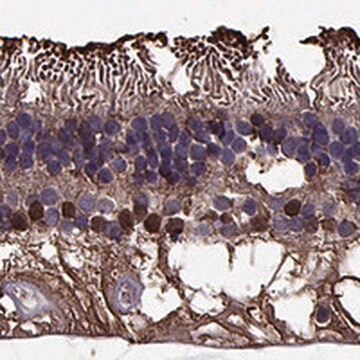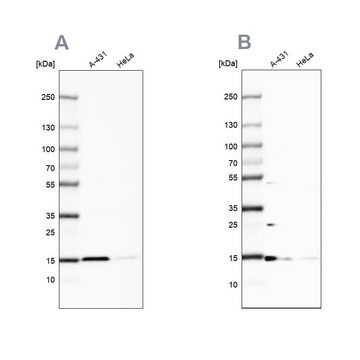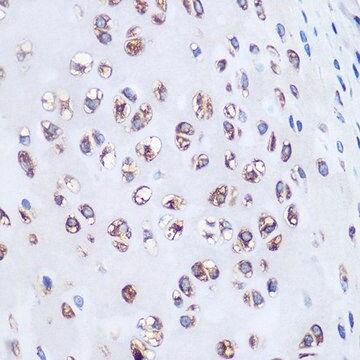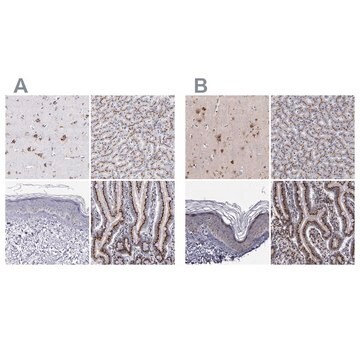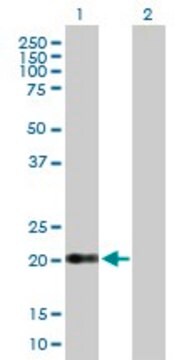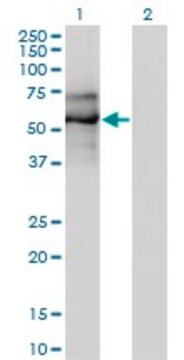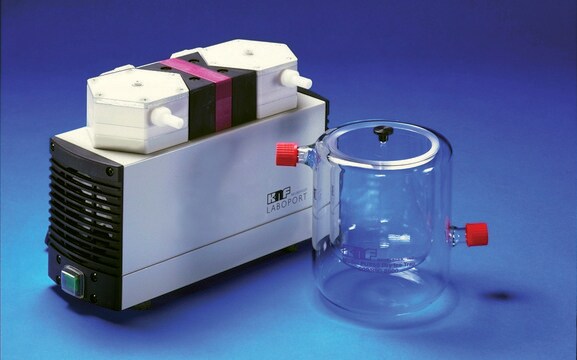推荐产品
生物源
rabbit
品質等級
共軛
unconjugated
抗體表格
purified immunoglobulin
抗體產品種類
primary antibodies
無性繁殖
polyclonal
形狀
buffered aqueous solution
分子量
antigen 36.5 kDa
物種活性
human
技術
western blot: 1 μg/mL
NCBI登錄號
UniProt登錄號
運輸包裝
dry ice
儲存溫度
−20°C
目標翻譯後修改
unmodified
基因資訊
human ... RLBP1(6017)
一般說明
Retinaldehyde binding protein 1 (RLBP1) mapped to human chromosome 15q26, encodes cellular retinaldehyde-binding protein (CRALBP).1 RLBP1 is a 36kDa water soluble protein and is expressed exclusively in retina and pineal gland.
The protein encoded by this gene is a 36kDa water-soluble protein which carries 11-cis-retinaldehyde or 11-cis-retinal as physiologic ligands. It may be a functional component of the visual cycle. Mutations of this gene have been associated with severe rod-cone dystrophy, Bothnia dystrophy (nonsyndromic autosomal recessive retinitis pigmentosa) and retinitis punctata albescens. (provided by RefSeq)
免疫原
RLBP1 (NP_000317.1, 1 a.a. ~ 317 a.a) full-length human protein.
Sequence
MSEGVGTFRMVPEEEQELRAQLEQLTTKDHGPVFGPCSQLPRHTLQKAKDELNEREETREEAVRELQEMVQAQAASGEELAVAVAERVQEKDSGFFLRFIRARKFNVGRAYELLRGYVNFRLQYPELFDSLSPEAVRCTIEAGYPGVLSSRDKYGRVVMLFNIENWQSQEITFDEILQAYCFILEKLLENEETQINGFCIIENFKGFTMQQAASLRTSDLRKMVDMLQDSFPARFKAIHFIHQPWYFTTTYNVVKPFLKSKLLERVFVHGDDLSGFYQEIDENILPSDFGGTLPKYDGKAVAEQLFGPQAQAENTAF
Sequence
MSEGVGTFRMVPEEEQELRAQLEQLTTKDHGPVFGPCSQLPRHTLQKAKDELNEREETREEAVRELQEMVQAQAASGEELAVAVAERVQEKDSGFFLRFIRARKFNVGRAYELLRGYVNFRLQYPELFDSLSPEAVRCTIEAGYPGVLSSRDKYGRVVMLFNIENWQSQEITFDEILQAYCFILEKLLENEETQINGFCIIENFKGFTMQQAASLRTSDLRKMVDMLQDSFPARFKAIHFIHQPWYFTTTYNVVKPFLKSKLLERVFVHGDDLSGFYQEIDENILPSDFGGTLPKYDGKAVAEQLFGPQAQAENTAF
生化/生理作用
Retinaldehyde binding protein 1 (RLBP1) plays a vital role in mammalian vision by directing 11-cis-retinoids for the conversion of photobleached opsin molecules into photosensitive visual pigments. Genetic variations in the gene leads to various autosomal recessive progressive retinopathy, including Bothnia dystrophy (BD) and retinitis, punctata albescens (RPA), Newfoundland rod-cone dystrophy (NFRCD), retinitis pigmentosa (RP) and fundus albipunctatus (FA).
外觀
Solution in phosphate buffered saline, pH 7.4
免責聲明
Unless otherwise stated in our catalog or other company documentation accompanying the product(s), our products are intended for research use only and are not to be used for any other purpose, which includes but is not limited to, unauthorized commercial uses, in vitro diagnostic uses, ex vivo or in vivo therapeutic uses or any type of consumption or application to humans or animals.
未找到合适的产品?
试试我们的产品选型工具.
儲存類別代碼
10 - Combustible liquids
水污染物質分類(WGK)
WGK 3
閃點(°F)
Not applicable
閃點(°C)
Not applicable
Molecular clues to Bothnia-type retinal dystrophy.
Xiaoqin He et al.
Advances in experimental medicine and biology, 723, 589-594 (2011-12-21)
Stephanie Hipp et al.
Acta ophthalmologica, 93(4), e281-e286 (2014-11-29)
Mutations in the RLBP1 gene encoding the cellular retinaldehyde-binding protein (CRALBP) cause autosomal recessive progressive retinopathy, such as retinitis punctata albescens (RPA), Bothnia-type dystrophy (BD), Newfoundland rod-cone dystrophy (NFRCD), retinitis pigmentosa (RP) and fundus albipunctatus (FA). We present the clinical
Xiaoqin He et al.
Proceedings of the National Academy of Sciences of the United States of America, 106(44), 18545-18550 (2009-10-23)
Cellular retinaldehyde-binding protein (CRALBP) is essential for mammalian vision by routing 11-cis-retinoids for the conversion of photobleached opsin molecules into photosensitive visual pigments. The arginine-to-tryptophan missense mutation in position 234 (R234W) in the human gene RLBP1 encoding CRALBP compromises visual
Elodie Dessalces et al.
JAMA ophthalmology, 131(10), 1314-1323 (2013-08-10)
Retinitis punctata albescens (RPA) is an autosomal recessive form of retinitis pigmentosa characterized by white dotlike deposits in the fundus, in most cases caused by mutations in RLBP1. To study disease progression and visual function in RPA. We performed clinical
我们的科学家团队拥有各种研究领域经验,包括生命科学、材料科学、化学合成、色谱、分析及许多其他领域.
联系技术服务部门
